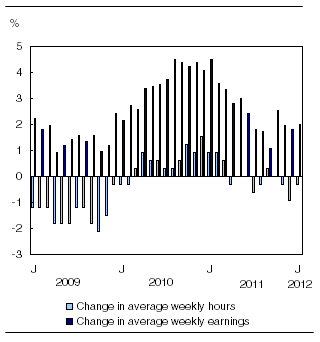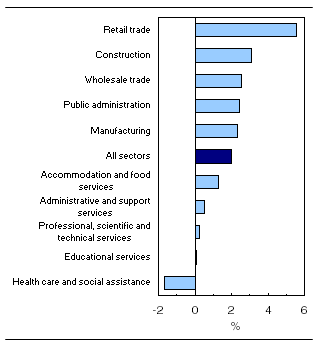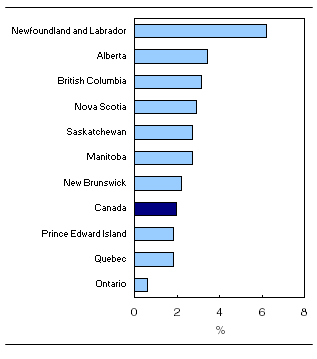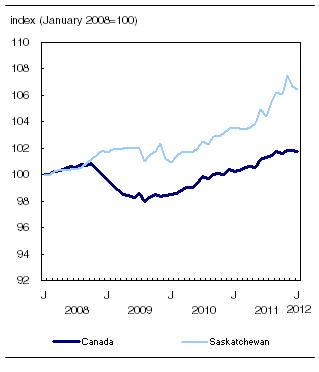Payroll employment, earnings and hours
Archived Content
Information identified as archived is provided for reference, research or recordkeeping purposes. It is not subject to the Government of Canada Web Standards and has not been altered or updated since it was archived. Please "contact us" to request a format other than those available.
Related subjects
-
[an error occurred while processing this directive]
In January, average weekly earnings of non-farm payroll employees were $888.89, up 0.6% from the previous month. On a year-over-year basis, earnings rose 2.0%.
The 2.0% increase in earnings during the 12 months to January reflects a number of factors, such as wage growth and changes in the composition of employment by industry, occupation and level of job experience.
Average hours worked per week can also contribute to changes in earnings. In January, the year-over-year growth in weekly earnings was dampened by a decline in hours worked. January was the the third consecutive month of year-over-year declines in hours worked. Non-farm payroll employees worked 32.9 hours per week on average in January, down from 33.0 hours a year earlier. Compared with December 2011, average weekly hours were up 0.1 hours from 32.8 hours.
Year-over-year change in average weekly hours and average weekly earnings

Chart description: Year-over-year change in average weekly hours and average weekly earnings
Average weekly earnings by sector
Year-over-year growth in average weekly earnings outpaced the national average of 2.0% in five of Canada's largest industrial sectors: retail trade; construction; wholesale trade; public administration; and manufacturing.
Note to readers
In March of every year, as part of the regularly scheduled year-end review of the Survey of Employment, Payrolls and Hours (SEPH), seasonally adjusted data are revised using the latest seasonal factors.
In addition, as part of the annual review, there were revisions to a small number of industries for the 2001 to 2011 period. These revisions affect both unadjusted and seasonally adjusted estimates. As a result, all estimates were revised historically back to 2001. These revised estimates are now available on CANSIM.
SEPH is a business census of non-farm payroll employees. Its key objective is to provide a monthly portrait of the level of earnings, the number of jobs and hours worked by detailed industry at the national, provincial and territorial level.
Statistics Canada also produces employment estimates from its monthly Labour Force Survey (LFS). The LFS is a household survey whose main objective is to divide the working-age population into three mutually exclusive groups: the employed (including the self-employed), unemployed and not in the labour force. This survey is the official source for the unemployment rate and collects data on the socio-demographic characteristics of all those in the labour market.
As a result of conceptual and methodological differences, estimates of changes from SEPH and LFS do differ from time to time. However, the trends in the data are quite similar.
Unless otherwise stated, this release presents seasonally adjusted data, which facilitates comparisons by removing the effects of seasonal variations.
Non-farm payroll employment data are for all hourly and salaried employees, as well as the "other employees" category, which includes piece-rate and commission-only employees.
Average weekly hours data are for hourly and salaried employees only and exclude businesses that could not be classified to a North American Industrial Classification System (NAICS) code.
All earnings data include overtime pay and exclude businesses that could not be classified to a NAICS code.
Average weekly earnings are derived by dividing total weekly earnings by the number of employees.
Year-over-year change in average weekly earnings in the 10 largest sectors, January 2011 to January 2012

In retail trade, average weekly earnings were $523.72, up 5.6% in the 12 months to January. Among the largest retail industries, clothing stores; electronic and appliances stores; gasoline stations; and sporting goods, hobby and musical instrument stores had the highest growth.
Average weekly earnings in construction increased 3.1% to $1,105.70, with notable growth in residential building construction; and among foundation, structure and building exterior contractors and other specialty trade contractors.
Year-over-year growth in earnings was also above the national average in wholesale trade, up 2.5% to $1,069.98 in January. The greatest increases were in wholesaler-distributors of miscellaneous products (e.g., recyclables, metals, agriculture supplies); motor vehicle and parts; building materials and supplies; and personal and household goods.
Average weekly earnings in public administration were up 2.4% to $1,129.42, with above-average growth in local, municipal and regional public administration.
In manufacturing, earnings increased by 2.3% to $1,008.63, led by increases in the manufacturing of paper, non-metallic mineral products, furniture, food, miscellaneous products (e.g., medical and office supplies as well as toys), and printing and related services.
Earnings' growth in some smaller sectors also surpassed the national average. From January 2011 to January 2012, earnings increased in the two highest-paying industries: mining, quarrying and oil and gas extraction, where they rose 8.2% to $1,842.59, and utilities, where they increased 4.3% to $1,686.56.
Average weekly earnings in health care and social assistance fell 1.7% to $800.39 in the 12 months to January, with the decline occurring in social assistance, hospitals and ambulatory health care services.
Average weekly earnings rise in every province
Average weekly earnings' growth was above the national average in seven provinces in the 12 months to January, with the highest growth in Newfoundland and Labrador. Prince Edward Island, along with the two largest provinces (Quebec and Ontario), had the lowest rates of growth.
Year-over-year growth in average weekly earnings by province, January 2011 to January 2012

In Newfoundland and Labrador, average weekly earnings were $919.86 in January, up 6.2% from 12 months earlier. Earnings in this province have been higher than the national average since September 2011.
In Alberta, average weekly earnings increased 3.5% to $1,065.46. This remained the highest level of earnings among the provinces, and was 20% higher than the national average in January.
In British Columbia, average weekly earnings rose 3.2% to $859.54, while in Nova Scotia, they increased by 2.9% to $779.92.
In Saskatchewan, average weekly earnings were $907.44, up 2.7% in the 12 months to January. Earnings in the province have exceeded the national average since August 2011 (see the "Provincial profile" section of this release).
The lowest year-over-year growth occurred in Ontario, where average weekly earnings were $903.22, up 0.6%. Year-over-year earnings growth in this province has been less than 2.0% since June 2011.
Non-farm payroll employment by sector
From December to January, total non-farm payroll employment declined by 1,700. There were decreases in transportation and warehousing; "other services;" accommodation and food services; and utilities. These declines were offset by gains in manufacturing; professional, scientific and technical services; construction; educational services; and wholesale trade.
On a year-over-year basis, the number of non-farm payroll employees rose by 1.5% (+229,600), with the highest rate of growth in mining, quarrying and oil and gas extraction (+5.7%); professional, scientific and technical services (+4.3%); construction (+3.9%); and accommodation and food services (+2.9%).
Provincial profile: Saskatchewan
From time to time, this release profiles an industrial sector or a province with a notable trend in employment, earnings or hours. This month, the focus is on Saskatchewan. This province has one of the lowest unemployment rates in the country, and has seen higher-than-average growth in non-farm payroll employment and average weekly earnings over the past two years.
In January, there were 458,800 non-farm payroll employees in Saskatchewan, which represents 3.0% of the national total. Between January 2011 and January 2012, payroll employment increased 2.8% (+12,400), the second-fastest provincial growth rate after Alberta and nearly double the national rate of 1.5%.
During the economic downturn in 2008 and 2009, non-farm payroll employment in Saskatchewan did not follow the national trend. Between August 2008 and August 2009, payroll employment in the province edged up by 0.4%, compared with a decline of 2.8% nationally. Payroll employment levels in Saskatchewan continued to increase, with an average growth of 2.7% in 2010 and 2011.
Non-farm payroll employment in Saskatchewan, January 2008 to January 2012

Chart description: Non-farm payroll employment in Saskatchewan, January 2008 to January 2012
In the 12 months to January 2012, payroll job gains in Saskatchewan were widespread across goods and services industries. The largest increases were in professional, scientific and technical services; manufacturing; transportation and warehousing; "other services;" and construction.
Average weekly earnings in Saskatchewan increased by 2.7% in the 12 months to January to $907.44. This is the third highest level of earnings of all provinces. Earnings in Saskatchewan have been higher than the national average since August 2011. This is the first period with earnings consistently above the national average since 2001, the first year for which comparable data are available.
In the 12 months to January 2012, the increase in earnings among the larger sectors was above the provincial average in professional, scientific and technical services; mining, quarrying and oil and gas extraction; accommodation and food services; educational services; construction; and administrative and support services.
Compared with the national average, Saskatchewan has a higher share of non-farm payroll employees working in mining, quarrying and oil and gas extraction; educational services; health care and social assistance as well as public administration. These sectors, which are generally higher paying, are a factor in Saskatchewan's high average earnings.
Weekly hours worked among employees in Saskatchewan averaged 32.7 hours in January, below the national average of 32.9 hours. In the 12 months to January, average weekly hours declined 0.9% in Saskatchewan, from 33.0 hours to 32.7 hours.
Available without charge in CANSIM: tables 281-0023 to 281-0039 and 281-0041 to 281-0049.
Definitions, data sources and methods: survey number 2612.
A data table is available from the Key resource module of our website under Summary tables.
Detailed industry data, data by size of enterprise based on employment, and other labour market indicators will soon be available in the monthly publication Employment, Earnings and Hours, vol. 90, no. 1 (72-002-X, free).
Data on payroll employment, earnings and hours for February will be released on April 26.
For more information, contact Statistics Canada's National Contact Centre (613-951-8116; toll-free 1-800-263-1136; infostats@statcan.gc.ca), Communications Division.
To enquire about the concepts, methods or data quality of this release, contact Jeannine Usalcas (613-951-4720), Labour Statistics Division.
- Date modified:
